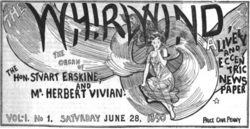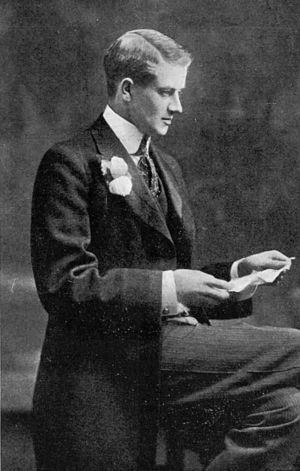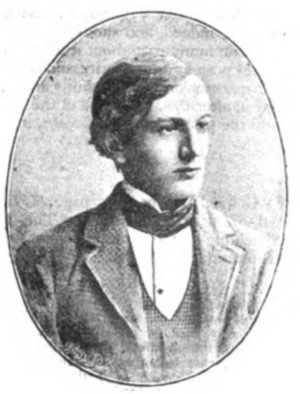The Whirlwind (newspaper) facts for kids

The title illustration of the first issue of The Whirlwind
|
|
| Type | Weekly newspaper |
|---|---|
| Owner(s) | Herbert Vivian, Ruaraidh Erskine |
| Founded | 28 June 1890 |
| Country | United Kingdom |
The Whirlwind was a newspaper in Britain that didn't last very long. It was published in 1890 and 1891. It was famous for its unique political ideas called Individualism. It also featured amazing artwork by artists like Walter Sickert and James Abbott McNeill Whistler. The newspaper strongly supported the Jacobite cause. It played a big part in the Neo-Jacobite Revival, which was a new interest in the Jacobite movement during the 1890s.
Contents
The Story of The Whirlwind Newspaper
A New Interest in the Jacobites
In 1886, a man named Bertram Ashburnham sent out a leaflet. He was looking for people who supported the Jacobite cause. After a failed uprising in 1745, Jacobites had to meet in secret. But by the late 1800s, it was okay to be a Jacobite again.
Many people responded to Ashburnham's leaflet. One of them was Melville Henry Massue. Massue and Ashburnham then created the Order of the White Rose. This was an open group for Jacobite supporters. The Order officially began on June 10, 1866.
The Order attracted people who wanted Ireland and Scotland to be independent. These groups joined together to support bringing back the House of Stuart. They also shared a dislike for the new scientific and democratic ideas of the time. Some even thought about trying to overthrow the current royal family, the Hanoverians. Their goal was to put Princess Maria Theresa on the British throne. You can learn more about this in Jacobite succession.
Two early and very excited members of the Order were Herbert Vivian and Ruaraidh Erskine. They had met at journalism school. They were eager to start a political campaign to bring back the Stuart royal family.
In 1889, the New Gallery in London held a big exhibition. It showed many items related to the House of Stuart. Queen Victoria herself lent some things to the show. So did the wife of her son, Prince Leopold, Duke of Albany. Jacobite families from England and Scotland also shared their items. The exhibition was very popular. It made many people interested in the Stuart monarchs again. The exhibition clearly showed Jacobite leanings. One historian, Guthrie, said that the exhibition's main point was to bring the idea of a Stuart restoration to the British public.
Starting The Whirlwind Newspaper
In 1890, Vivian and Erskine started a weekly newspaper. They called it The Whirlwind, A Lively and Eccentric Newspaper. Vivian was the editor. The paper openly supported the Jacobite viewpoint. It also promoted a very strong form of Individualism. This idea focuses on the freedom and rights of each person.
The Short Life of The Whirlwind
The Whirlwind was known for publishing drawings by famous artists. These included Whistler and Walter Sickert. Sickert was also the art critic for The Whirlwind. He wrote a weekly column. The paper also had articles about Oscar Wilde, who was very famous then. The newspaper promoted Individualist and Jacobite political views. Erskine and Vivian strongly supported these ideas.
One famous drawing by Sickert for The Whirlwind was a portrait of Charles Bradlaugh. Bradlaugh also wrote an article for the paper about "practical individualism."
Erskine's articles in The Whirlwind were often about serious politics. He wrote that taxes should be voluntary. He also wrote against women getting the right to vote.
Vivian was more interested in social events and criticizing people he didn't agree with. He wrote several articles attacking Henry Morton Stanley. He also criticized London's tram system because he believed in individual freedom. He wrote a series called "Letters to Absurd People." In these letters, he made fun of politicians like Arthur Balfour and George Goschen. He also criticized Henry Edward Manning, who was an Archbishop.
The newspaper's early success made Vivian and Erskine more ambitious. In 1891, they left The Order of the White Rose. They formed a new group with Massue called the Legitimist Jacobite League of Great Britain and Ireland. This new group was much more focused on politics. The Order of the White Rose was becoming more about art. One historian, Pittock, said the League promoted Jacobitism more than anyone had since the 1700s.
In August 1890, the paper published an article by William Henry Wilkins. He was a friend of Vivian's from Cambridge University. Wilkins suggested that important decisions, like Irish Home Rule (allowing Ireland to govern itself) or separating the Church of England from the state, should be decided by public votes instead of by the King or Queen.
In October 1890, the printers of The Whirlwind refused to print an issue. This was because it included a very strong article called "Young England." Erskine and Vivian quickly sued the printers. They wanted money for the income they lost from the cancelled issue.
The End of the Newspaper
The issue of The Whirlwind from November 8, 1890, was the last one to show Erskine's name. From issue 20 onwards, his name was crossed out. Vivian produced these issues by himself. The paper briefly mentioned Erskine's absence. It said he was on an important mission and wished him well.
The 26th issue of the paper came out on December 27, 1890. It had fewer pages than usual. It started with a note from Vivian called "Not Dead but sleepy." He wrote that there would be no Christmas issue. A special edition would come out on his birthday, April 3, 1891. He said The Whirlwind would "hibernate" for three months. Vivian explained that running the paper took all his time. He planned to spend the next three months working on political organization.
Early in 1891, Vivian announced he would run for election in Bradford East. Erskine said he would run in Buteshire.
In April 1891, even with their political plans, Erskine and Vivian tried to get money to restart the newspaper. But The Whirlwind never started publishing again. Its 26 issues had been lively and unusual. They were full of strong opinions, personal attacks, political essays, and drawings by some of the best artists of the time.




